ACC 304 Taxation Law: Tax Practice Assignment - Residency & Income
VerifiedAdded on 2023/03/30
|10
|1164
|198
Report
AI Summary
This report provides a comprehensive analysis of taxation law, focusing on the determination of residency status and the assessment of partnership income. Part A assesses an individual's residency based on statutory definitions and various tests, including the Ordinary Test, Domicile Test, 183-Day Test, and Commonwealth Superannuation Test, ultimately concluding the individual is a non-resident. Part B details the calculation of net partnership income and its distribution among partners. Part C includes a video transcript explaining the rationale behind the residency determination and income calculation. The report references relevant legal cases and legislation, such as the ITAA 1936 and the Domicile Act 1982. Desklib offers a wide array of similar solved assignments and resources for students.

Running head: TAXATION LAW
TAXATION LAW
Name of Student
Name of University
Author’s Note
TAXATION LAW
Name of Student
Name of University
Author’s Note
Paraphrase This Document
Need a fresh take? Get an instant paraphrase of this document with our AI Paraphraser

1TAXATION LAW
Table of Contents
Part A...............................................................................................................................................2
Private and Confidential: Letter of Advice..................................................................................2
Statutory Definition:........................................................................................................................2
Ordinary Test/Resident Test:.......................................................................................................3
Domicile Test:.............................................................................................................................3
183-Day Test:..............................................................................................................................4
Commonwealth Superannuation Test:.........................................................................................4
Part B...............................................................................................................................................5
Net Income of Partnership:..........................................................................................................5
Distribution Statement:................................................................................................................6
Part C: Video Transcript:.................................................................................................................6
References:..................................................................................................................................8
Table of Contents
Part A...............................................................................................................................................2
Private and Confidential: Letter of Advice..................................................................................2
Statutory Definition:........................................................................................................................2
Ordinary Test/Resident Test:.......................................................................................................3
Domicile Test:.............................................................................................................................3
183-Day Test:..............................................................................................................................4
Commonwealth Superannuation Test:.........................................................................................4
Part B...............................................................................................................................................5
Net Income of Partnership:..........................................................................................................5
Distribution Statement:................................................................................................................6
Part C: Video Transcript:.................................................................................................................6
References:..................................................................................................................................8
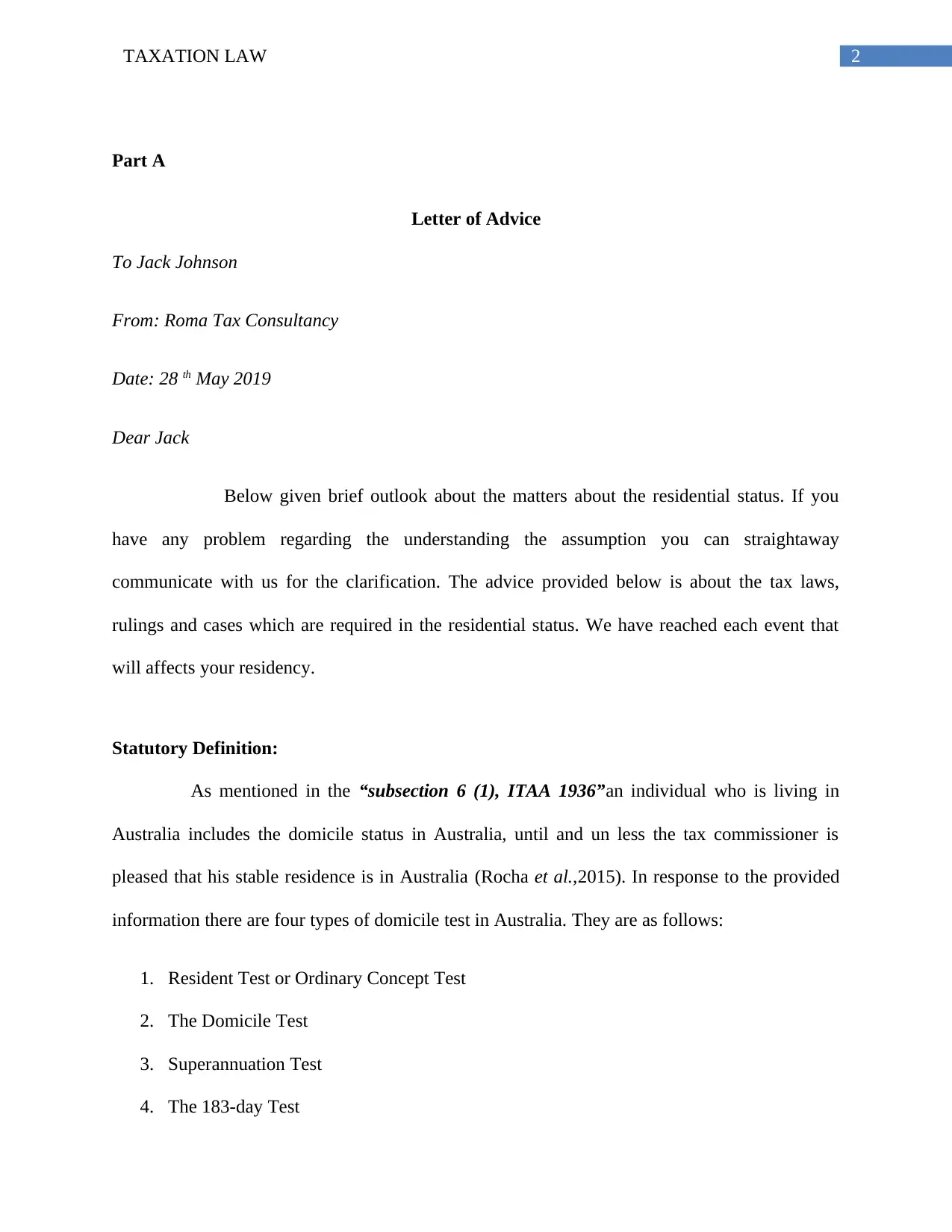
2TAXATION LAW
Part A
Letter of Advice
To Jack Johnson
From: Roma Tax Consultancy
Date: 28 th May 2019
Dear Jack
Below given brief outlook about the matters about the residential status. If you
have any problem regarding the understanding the assumption you can straightaway
communicate with us for the clarification. The advice provided below is about the tax laws,
rulings and cases which are required in the residential status. We have reached each event that
will affects your residency.
Statutory Definition:
As mentioned in the “subsection 6 (1), ITAA 1936”an individual who is living in
Australia includes the domicile status in Australia, until and un less the tax commissioner is
pleased that his stable residence is in Australia (Rocha et al.,2015). In response to the provided
information there are four types of domicile test in Australia. They are as follows:
1. Resident Test or Ordinary Concept Test
2. The Domicile Test
3. Superannuation Test
4. The 183-day Test
Part A
Letter of Advice
To Jack Johnson
From: Roma Tax Consultancy
Date: 28 th May 2019
Dear Jack
Below given brief outlook about the matters about the residential status. If you
have any problem regarding the understanding the assumption you can straightaway
communicate with us for the clarification. The advice provided below is about the tax laws,
rulings and cases which are required in the residential status. We have reached each event that
will affects your residency.
Statutory Definition:
As mentioned in the “subsection 6 (1), ITAA 1936”an individual who is living in
Australia includes the domicile status in Australia, until and un less the tax commissioner is
pleased that his stable residence is in Australia (Rocha et al.,2015). In response to the provided
information there are four types of domicile test in Australia. They are as follows:
1. Resident Test or Ordinary Concept Test
2. The Domicile Test
3. Superannuation Test
4. The 183-day Test
⊘ This is a preview!⊘
Do you want full access?
Subscribe today to unlock all pages.

Trusted by 1+ million students worldwide
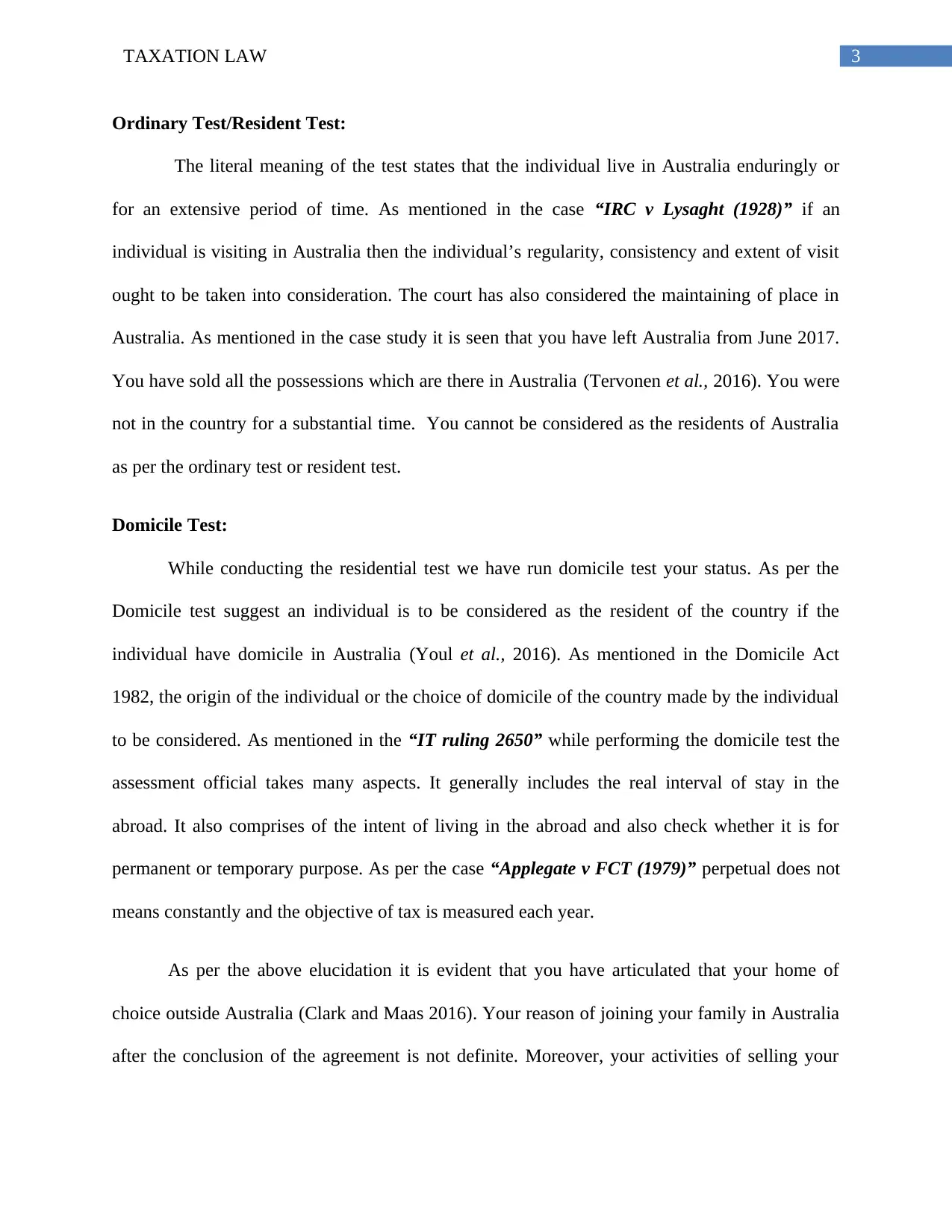
3TAXATION LAW
Ordinary Test/Resident Test:
The literal meaning of the test states that the individual live in Australia enduringly or
for an extensive period of time. As mentioned in the case “IRC v Lysaght (1928)” if an
individual is visiting in Australia then the individual’s regularity, consistency and extent of visit
ought to be taken into consideration. The court has also considered the maintaining of place in
Australia. As mentioned in the case study it is seen that you have left Australia from June 2017.
You have sold all the possessions which are there in Australia (Tervonen et al., 2016). You were
not in the country for a substantial time. You cannot be considered as the residents of Australia
as per the ordinary test or resident test.
Domicile Test:
While conducting the residential test we have run domicile test your status. As per the
Domicile test suggest an individual is to be considered as the resident of the country if the
individual have domicile in Australia (Youl et al., 2016). As mentioned in the Domicile Act
1982, the origin of the individual or the choice of domicile of the country made by the individual
to be considered. As mentioned in the “IT ruling 2650” while performing the domicile test the
assessment official takes many aspects. It generally includes the real interval of stay in the
abroad. It also comprises of the intent of living in the abroad and also check whether it is for
permanent or temporary purpose. As per the case “Applegate v FCT (1979)” perpetual does not
means constantly and the objective of tax is measured each year.
As per the above elucidation it is evident that you have articulated that your home of
choice outside Australia (Clark and Maas 2016). Your reason of joining your family in Australia
after the conclusion of the agreement is not definite. Moreover, your activities of selling your
Ordinary Test/Resident Test:
The literal meaning of the test states that the individual live in Australia enduringly or
for an extensive period of time. As mentioned in the case “IRC v Lysaght (1928)” if an
individual is visiting in Australia then the individual’s regularity, consistency and extent of visit
ought to be taken into consideration. The court has also considered the maintaining of place in
Australia. As mentioned in the case study it is seen that you have left Australia from June 2017.
You have sold all the possessions which are there in Australia (Tervonen et al., 2016). You were
not in the country for a substantial time. You cannot be considered as the residents of Australia
as per the ordinary test or resident test.
Domicile Test:
While conducting the residential test we have run domicile test your status. As per the
Domicile test suggest an individual is to be considered as the resident of the country if the
individual have domicile in Australia (Youl et al., 2016). As mentioned in the Domicile Act
1982, the origin of the individual or the choice of domicile of the country made by the individual
to be considered. As mentioned in the “IT ruling 2650” while performing the domicile test the
assessment official takes many aspects. It generally includes the real interval of stay in the
abroad. It also comprises of the intent of living in the abroad and also check whether it is for
permanent or temporary purpose. As per the case “Applegate v FCT (1979)” perpetual does not
means constantly and the objective of tax is measured each year.
As per the above elucidation it is evident that you have articulated that your home of
choice outside Australia (Clark and Maas 2016). Your reason of joining your family in Australia
after the conclusion of the agreement is not definite. Moreover, your activities of selling your
Paraphrase This Document
Need a fresh take? Get an instant paraphrase of this document with our AI Paraphraser
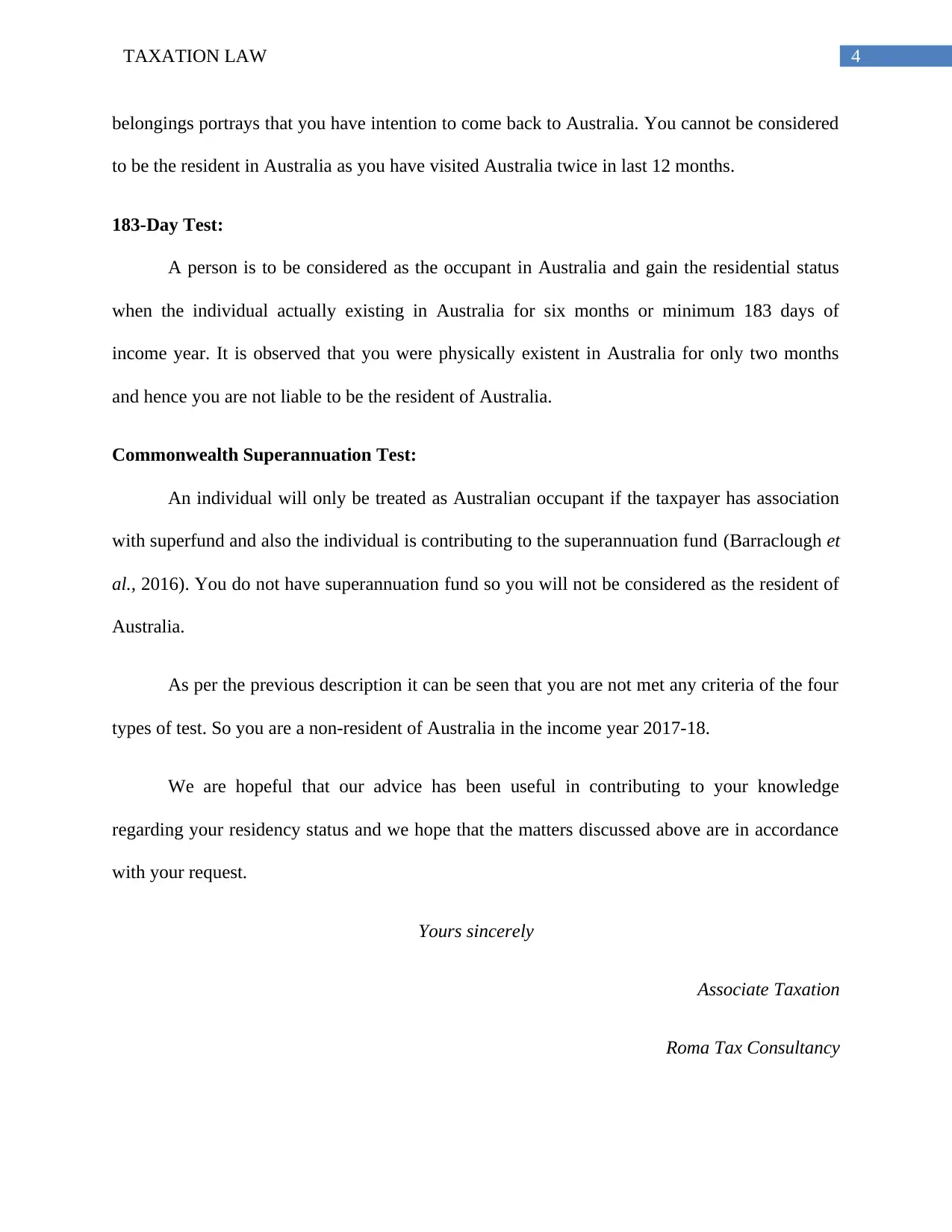
4TAXATION LAW
belongings portrays that you have intention to come back to Australia. You cannot be considered
to be the resident in Australia as you have visited Australia twice in last 12 months.
183-Day Test:
A person is to be considered as the occupant in Australia and gain the residential status
when the individual actually existing in Australia for six months or minimum 183 days of
income year. It is observed that you were physically existent in Australia for only two months
and hence you are not liable to be the resident of Australia.
Commonwealth Superannuation Test:
An individual will only be treated as Australian occupant if the taxpayer has association
with superfund and also the individual is contributing to the superannuation fund (Barraclough et
al., 2016). You do not have superannuation fund so you will not be considered as the resident of
Australia.
As per the previous description it can be seen that you are not met any criteria of the four
types of test. So you are a non-resident of Australia in the income year 2017-18.
We are hopeful that our advice has been useful in contributing to your knowledge
regarding your residency status and we hope that the matters discussed above are in accordance
with your request.
Yours sincerely
Associate Taxation
Roma Tax Consultancy
belongings portrays that you have intention to come back to Australia. You cannot be considered
to be the resident in Australia as you have visited Australia twice in last 12 months.
183-Day Test:
A person is to be considered as the occupant in Australia and gain the residential status
when the individual actually existing in Australia for six months or minimum 183 days of
income year. It is observed that you were physically existent in Australia for only two months
and hence you are not liable to be the resident of Australia.
Commonwealth Superannuation Test:
An individual will only be treated as Australian occupant if the taxpayer has association
with superfund and also the individual is contributing to the superannuation fund (Barraclough et
al., 2016). You do not have superannuation fund so you will not be considered as the resident of
Australia.
As per the previous description it can be seen that you are not met any criteria of the four
types of test. So you are a non-resident of Australia in the income year 2017-18.
We are hopeful that our advice has been useful in contributing to your knowledge
regarding your residency status and we hope that the matters discussed above are in accordance
with your request.
Yours sincerely
Associate Taxation
Roma Tax Consultancy

5TAXATION LAW
Part B
Net Income of Partnership:
Part B
Net Income of Partnership:
⊘ This is a preview!⊘
Do you want full access?
Subscribe today to unlock all pages.

Trusted by 1+ million students worldwide
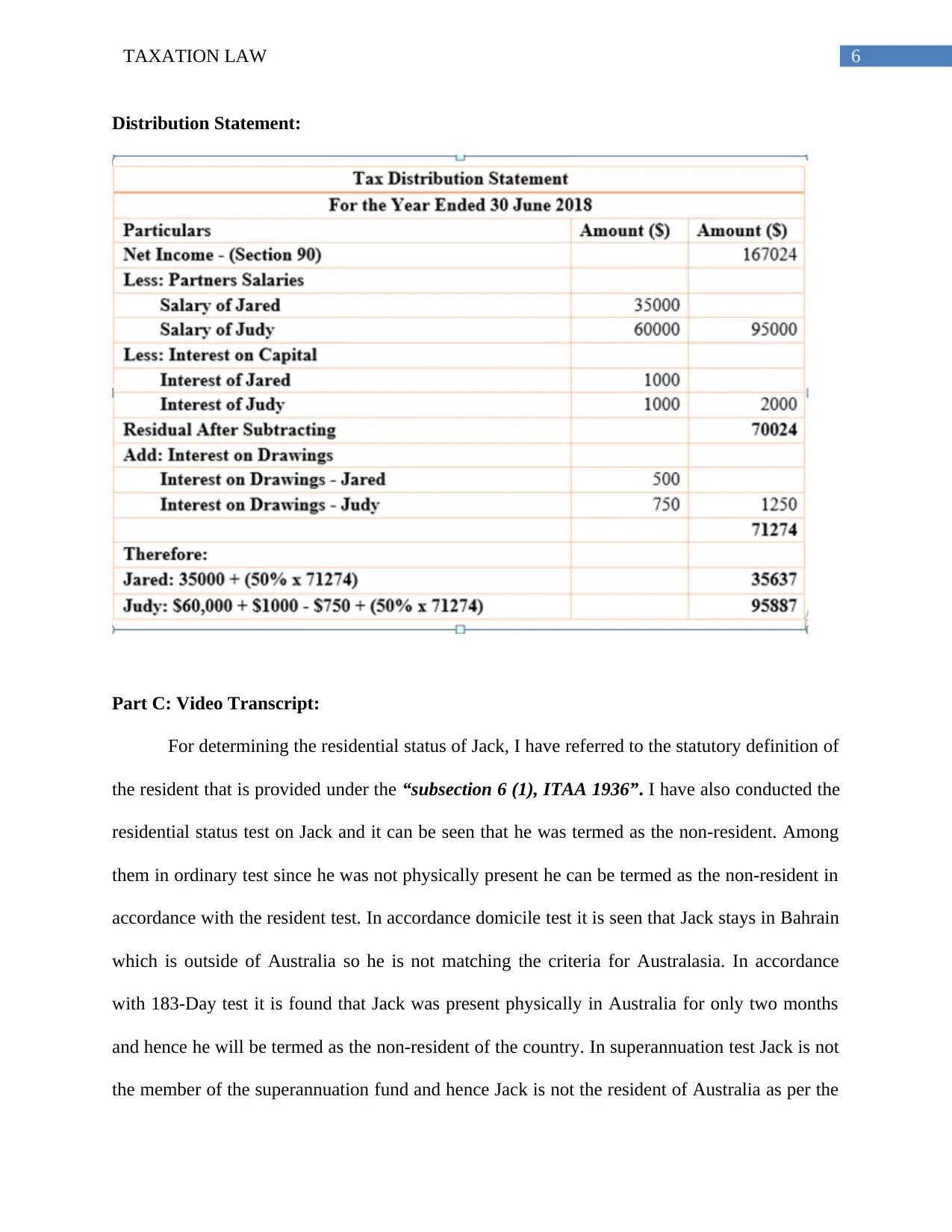
6TAXATION LAW
Distribution Statement:
Part C: Video Transcript:
For determining the residential status of Jack, I have referred to the statutory definition of
the resident that is provided under the “subsection 6 (1), ITAA 1936”. I have also conducted the
residential status test on Jack and it can be seen that he was termed as the non-resident. Among
them in ordinary test since he was not physically present he can be termed as the non-resident in
accordance with the resident test. In accordance domicile test it is seen that Jack stays in Bahrain
which is outside of Australia so he is not matching the criteria for Australasia. In accordance
with 183-Day test it is found that Jack was present physically in Australia for only two months
and hence he will be termed as the non-resident of the country. In superannuation test Jack is not
the member of the superannuation fund and hence Jack is not the resident of Australia as per the
Distribution Statement:
Part C: Video Transcript:
For determining the residential status of Jack, I have referred to the statutory definition of
the resident that is provided under the “subsection 6 (1), ITAA 1936”. I have also conducted the
residential status test on Jack and it can be seen that he was termed as the non-resident. Among
them in ordinary test since he was not physically present he can be termed as the non-resident in
accordance with the resident test. In accordance domicile test it is seen that Jack stays in Bahrain
which is outside of Australia so he is not matching the criteria for Australasia. In accordance
with 183-Day test it is found that Jack was present physically in Australia for only two months
and hence he will be termed as the non-resident of the country. In superannuation test Jack is not
the member of the superannuation fund and hence Jack is not the resident of Australia as per the
Paraphrase This Document
Need a fresh take? Get an instant paraphrase of this document with our AI Paraphraser
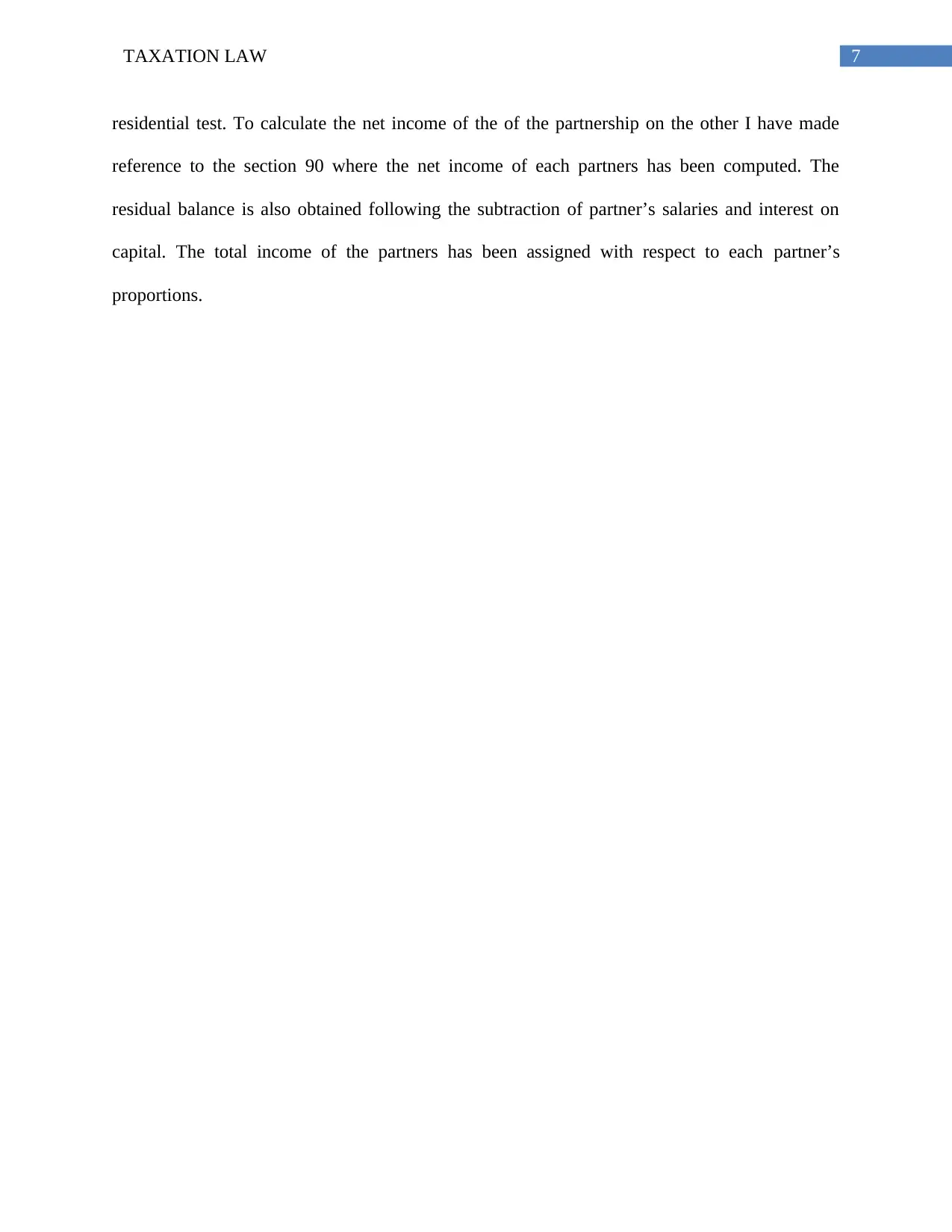
7TAXATION LAW
residential test. To calculate the net income of the of the partnership on the other I have made
reference to the section 90 where the net income of each partners has been computed. The
residual balance is also obtained following the subtraction of partner’s salaries and interest on
capital. The total income of the partners has been assigned with respect to each partner’s
proportions.
residential test. To calculate the net income of the of the partnership on the other I have made
reference to the section 90 where the net income of each partners has been computed. The
residual balance is also obtained following the subtraction of partner’s salaries and interest on
capital. The total income of the partners has been assigned with respect to each partner’s
proportions.
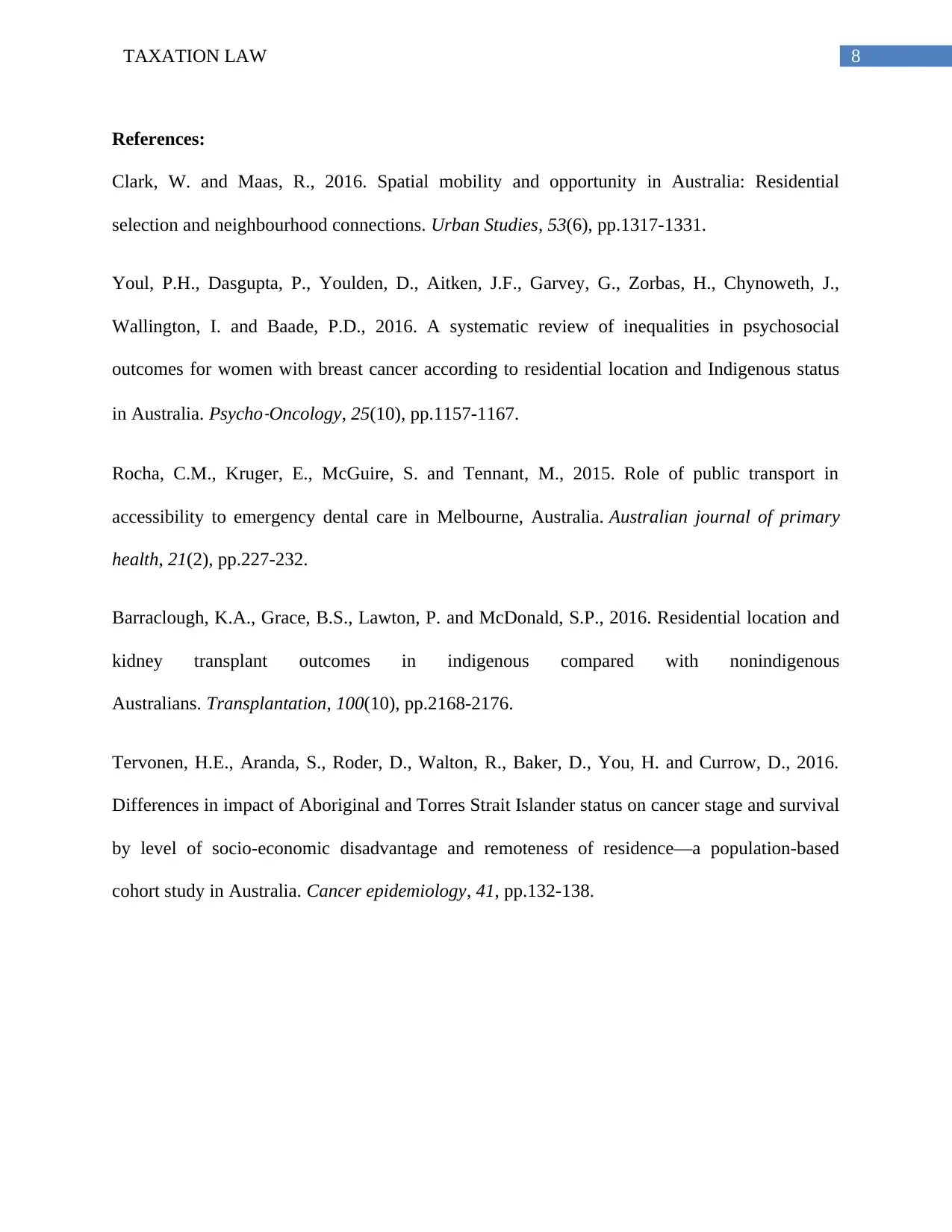
8TAXATION LAW
References:
Clark, W. and Maas, R., 2016. Spatial mobility and opportunity in Australia: Residential
selection and neighbourhood connections. Urban Studies, 53(6), pp.1317-1331.
Youl, P.H., Dasgupta, P., Youlden, D., Aitken, J.F., Garvey, G., Zorbas, H., Chynoweth, J.,
Wallington, I. and Baade, P.D., 2016. A systematic review of inequalities in psychosocial
outcomes for women with breast cancer according to residential location and Indigenous status
in Australia. Psycho
‐Oncology, 25(10), pp.1157-1167.
Rocha, C.M., Kruger, E., McGuire, S. and Tennant, M., 2015. Role of public transport in
accessibility to emergency dental care in Melbourne, Australia. Australian journal of primary
health, 21(2), pp.227-232.
Barraclough, K.A., Grace, B.S., Lawton, P. and McDonald, S.P., 2016. Residential location and
kidney transplant outcomes in indigenous compared with nonindigenous
Australians. Transplantation, 100(10), pp.2168-2176.
Tervonen, H.E., Aranda, S., Roder, D., Walton, R., Baker, D., You, H. and Currow, D., 2016.
Differences in impact of Aboriginal and Torres Strait Islander status on cancer stage and survival
by level of socio-economic disadvantage and remoteness of residence—a population-based
cohort study in Australia. Cancer epidemiology, 41, pp.132-138.
References:
Clark, W. and Maas, R., 2016. Spatial mobility and opportunity in Australia: Residential
selection and neighbourhood connections. Urban Studies, 53(6), pp.1317-1331.
Youl, P.H., Dasgupta, P., Youlden, D., Aitken, J.F., Garvey, G., Zorbas, H., Chynoweth, J.,
Wallington, I. and Baade, P.D., 2016. A systematic review of inequalities in psychosocial
outcomes for women with breast cancer according to residential location and Indigenous status
in Australia. Psycho
‐Oncology, 25(10), pp.1157-1167.
Rocha, C.M., Kruger, E., McGuire, S. and Tennant, M., 2015. Role of public transport in
accessibility to emergency dental care in Melbourne, Australia. Australian journal of primary
health, 21(2), pp.227-232.
Barraclough, K.A., Grace, B.S., Lawton, P. and McDonald, S.P., 2016. Residential location and
kidney transplant outcomes in indigenous compared with nonindigenous
Australians. Transplantation, 100(10), pp.2168-2176.
Tervonen, H.E., Aranda, S., Roder, D., Walton, R., Baker, D., You, H. and Currow, D., 2016.
Differences in impact of Aboriginal and Torres Strait Islander status on cancer stage and survival
by level of socio-economic disadvantage and remoteness of residence—a population-based
cohort study in Australia. Cancer epidemiology, 41, pp.132-138.
⊘ This is a preview!⊘
Do you want full access?
Subscribe today to unlock all pages.

Trusted by 1+ million students worldwide

9TAXATION LAW
1 out of 10
Related Documents
Your All-in-One AI-Powered Toolkit for Academic Success.
+13062052269
info@desklib.com
Available 24*7 on WhatsApp / Email
![[object Object]](/_next/static/media/star-bottom.7253800d.svg)
Unlock your academic potential
Copyright © 2020–2025 A2Z Services. All Rights Reserved. Developed and managed by ZUCOL.





